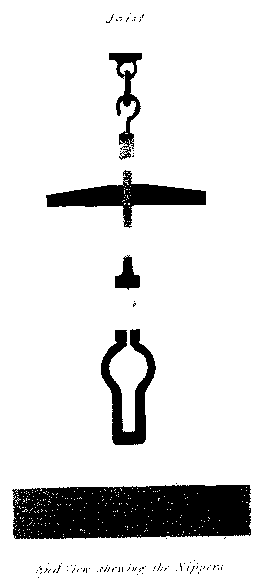
The lever was used as in the former case, but the metals were held by nippers, as indicated in the drawing No. 2. They were made of wrought iron, and their ends adapted to receive the bars, which, by being tapered at both extremities, and increasing in diameter from the actual section (if I may so express it), and the jaws of the nippers being confined by a hoop, confined both. The bars, which were six inches long, and 1/4 square, were thus fairly and firmly grasped.
| April 30th, 1817. | ||||
| lbs. | ||||
| No. | 45 ¼ inch, | cast iron bar, horizontal | 1166 | } 1193.5 |
| 46 ¼ do. | do. vertical | 1218 | ||
| 47 ¼ do. | cast steel previously tilted | 8391 | ||
| 48 ¼ do. | blister steel, reduced per hammer | 8322 | ||
| 49 ¼ do. | shear steel, do. do. | 7977 | ||
| 50 ¼ do. | Swedish iron, do. do. | 4504 | ||
| 51 ¼ do. | English iron, do. do. | 3492 | ||
| 52 ¼ do. | hard gun metal, mean of two trials | 2273 | ||
| 53 ¼ do. | wrought copper reduced per hammer | 2112 | ||
| 54 ¼ do. | cast copper | 1192 |
